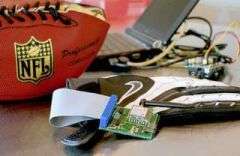December 19, 2008 weblog
Sensor-equipped footballs could help refs and players

(PhysOrg.com) -- When Dr. Priya Narasimhan moved to Pittsburgh seven years ago, she fell in love with the people, the city, and the Pittsburgh Steelers. Although the Carnegie Mellon computer engineering professor grew up in India and Africa, she became passionate about the American sport of football, including its bad calls and referees' human error.
After getting tired of throwing things at the TV during unfair calls, Narasimhan wondered if it would be possible to improve the accuracy of the referees' decisions by adding sensor technology to the instant replays. She began working on a way to equip the football with a GPS receiver and an accelerometer that could help refs make calls such as whether the ball was caught before it hit the ground, or if a player had possession before fumbling. She has also designed gloves with 15 touch sensors that wirelessly transmit data to a computer. The data can show a player's grip by sensing which parts of the glove are in contact with ball at any given time, and provide information on how an individual player throws the ball.
Narasimhan hopes that the technology will be used for training referees and players, and possibly scouting. She doesn't intend for the electronics to take any of the fun out of the game.
"You'd never want to replace the human referees because they make these calls based on years of experience, and no technology can replace that," she said. "But in addition to the instant replay, if you had a supplementary system that said this is exactly where the ball landed and where the player stopped with it, you could make these kinds of calls accurately."
Besides being used in games, the technology could be used to help coaches, for instance, when they need to replace a second-string quarterback. Potential replacements could wear the sensor-laden gloves while throwing and running, and coaches could tell how the players react in different situations. "You could have whoever you're scouting wear these gloves and you could ask, well, does he throw the same way under the same defensive schemes or does he run the same way and make the same kind of cuts as a terrific running back does?" she said.
The technology still needs improvement to be useful, though. The current prototype transmits information just once a second and is only accurate to within 30 feet. Narasimhan and her students are working on a newer prototype that can transmit information four times per second and combine data from fixed GPS receivers near the field for greater accuracy.
Besides the ball and gloves, sensors could one day be added to players' shoes to measure running stride and patterns, or in shoulder pads to calculate blocking positions and force. Narasimhan hopes to work with a college or pro team to get players' input on what kind of information would be most helpful for improving their game.
via: Pittsburgh Post-Gazette and Gizmodo
© 2008 PhysOrg.com





















